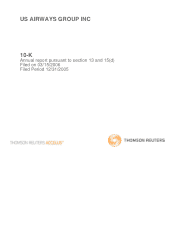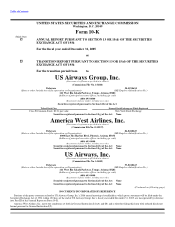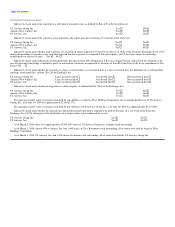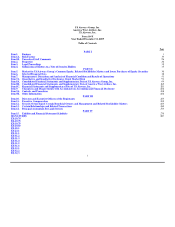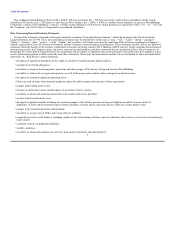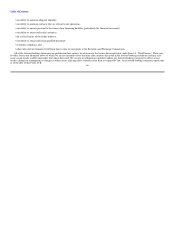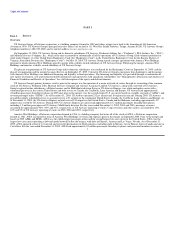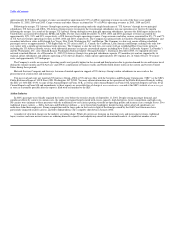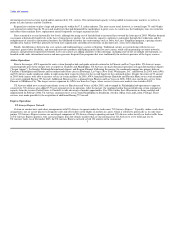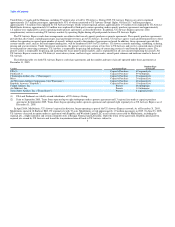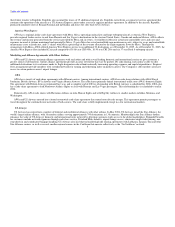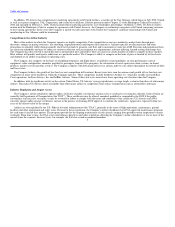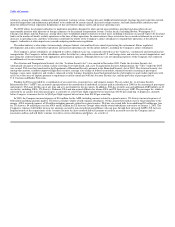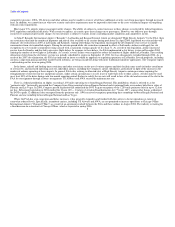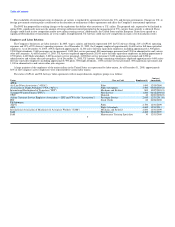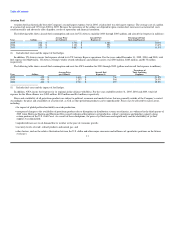US Airways 2005 Annual Report Download - page 8
Download and view the complete annual report
Please find page 8 of the 2005 US Airways annual report below. You can navigate through the pages in the report by either clicking on the pages listed below, or by using the keyword search tool below to find specific information within the annual report.
Table of Contents
approximately $2.5 billion. Passenger revenues accounted for approximately 93% of AWA's operating revenues in each of the three years ended
December 31, 2005, 2004 and 2003. Cargo revenues and other sources accounted for 7% of AWA's operating revenues in 2005, 2004 and 2003.
Following the merger, US Airways Group began moving toward operating under the single brand name of "US Airways" through its two principal
subsidiaries: US Airways and AWA. US Airways Group expects to integrate the two principal subsidiaries into one operation over the first 24 months
following the merger. As a result of the merger, US Airways Group, through its two principal operating subsidiaries, operates the fifth largest airline in the
United States as measured by domestic RPMs and ASMs. For the years ended December 31, 2005, 2004 and 2003, passenger revenues accounted for
approximately 92%, 93% and 93%, respectively, of US Airways Group's operating revenues. Cargo revenues and other sources accounted for 8%, 7% and 7%
of US Airways Group's operating revenues in 2005, 2004 and 2003, respectively. The Company has primary hubs in Charlotte, Philadelphia and Phoenix and
secondary hubs/focus cities in Pittsburgh, Las Vegas, New York, Washington, D.C. and Boston. The Company is a low-cost carrier offering scheduled
passenger service on approximately 3,700 flights daily to 233 cities in the U.S., Canada, the Caribbean, Latin America and Europe, making it the only low-
cost carrier with a significant international route presence. The Company is also the only low-cost carrier with an established East Coast route network,
including the US Airways Shuttle service, with substantial presence at capacity constrained airports including New York's LaGuardia Airport ("LaGuardia")
and the Washington, D.C. area's Ronald Reagan Washington National Airport ("Reagan National"). Starting in December 2005, we expanded our route
network to include Hawaii. As of December 31, 2005, US Airways Group's two principal subsidiaries operate 373 mainline jets and are supported by its
regional airline subsidiaries and affiliates operating as US Airways Express, which operate approximately 255 regional jets, of which 80 have 70 or more
seats, and approximately 107 turboprops.
The Company's results are seasonal. Operating results are typically highest in the second and third quarters due to greater demand for air and leisure travel
during the summer months and US Airways' and AWA's combination of business traffic and North-South leisure traffic in the eastern and western United
States during those periods.
Material Services Company and Airways Assurance Limited operate in support of US Airways Group's airline subsidiaries in areas such as the
procurement of aviation fuel and insurance.
You may read and copy any materials US Airways Group, AWA or US Airways files with the Securities and Exchange Commission ("SEC") at the SEC's
Public Reference Room at 100 F Street, NE, Washington, DC 20549. You may obtain information on the operation of the Public Reference Room by calling
the SEC at 1-800-SEC-0330. A copy of this Annual Report on Form 10-K, as well as other Annual Reports on Form 10-K, Quarterly Reports on Form 10-Q,
Current Reports on Form 8-K and amendments to those reports are accessible free of charge at www.usairways.com and at the SEC's website at www.sec.gov
as soon as reasonably possible after the report is filed with or furnished to the SEC.
Airline Industry
In 2005, passenger travel finally regained the levels seen before the terrorist attacks of September 11, 2001. Despite strong passenger demand, and
significant efforts by carriers to contain costs, the industry remained largely mired with excess capacity, high fuel prices, fierce competition, and high costs.
No carriers were immune to these pressures with the traditional low cost carriers posting virtually no operating profits and in many cases, outright losses. Two
traditional legacy carriers — Delta Air Lines and Northwest Airlines — were forced into bankruptcy despite having earlier achieved significant cost
reductions from their employees. Strong competition and the large spike in fuel costs in light of the damage caused by the Gulf Coast hurricanes have
particularly impacted smaller carriers, and led to Independence Air's complete shut down in January 2006.
A number of structural changes in the industry are taking shape. While all carriers are focusing on lowering costs and increasing revenues, traditional
legacy carriers and some newer carriers are reducing domestic capacity and redeploying aircraft in international markets. A significant number of new
2

